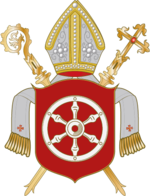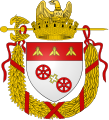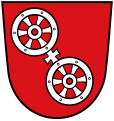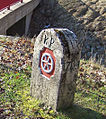Mainz wheel
The Mainz wheel is a common figure in the heraldry of the city of Mainz in Rhineland-Palatinate . It is a coat of arms picture with proper names, which shows a six-spoke silver-colored wheel on a red background. In order to distinguish itself from the former Mainz spa state , the city has a double wheel connected with a cross in its coat of arms instead of a single one. The state of Rhineland-Palatinate and many municipalities that are historically connected to the city or the Electorate of Mainz also have the wheel in their coat of arms. In addition, it can be found on many stone carvings - for example on old boundary stones - as well as on medieval seals and similar works.
Emergence
The Mainz coat of arms, derived from the badge of the Diocese of Mainz , can be seen as a double wheel on coins of Archbishop Siegfried III. von Eppstein (1230–1249). At that time, Mainz was the center of the Rhenish Association of Cities . From the 14th century it was connected with a cross to form a double wheel. Two centuries later, it was positioned diagonally as a silver wheel in the red field. When Worbis belonged to the Archdiocese of Mainz (14th century), it changed its coat of arms and seal after being awarded by Archbishop Daniel Brendel von Homburg in 1576, which still shows the wheel today.
The origin of the Mainz wheel has not yet been clearly clarified. There are numerous legends and one theory that is believed to be likely.
Willigis legend
One tradition refers to Bishop Willigis , who was elected Archbishop of Mainz in 975 and is said to have been the son of a Wagner . In order to emphasize its simple origins, Willigis is said to have chosen the wheel, one of the most important products of the Wagner profession, as a coat of arms. According to scientific research, however, this is not tenable, as coats of arms have only existed since the 12th century.
The late medieval tradition has become popular through the German sagas of the Brothers Grimm :
“In the year 1009 Willegis, a pious and learned man, was elected Bishop of Mainz; but he was of poor, poor origin and his father was a Wagner man. The aristocratic tumblers and fellow canons hated him, took chalk and annoyingly painted wheels on the walls and doors of his castle; intended to do him a disgrace with it. When the pious bishop heard their mockery, he ordered a painter to be called; He ordered him to paint white wheels in red fields in all his rooms with good color, and added a rhyme that said: "Willegis, Willegis, think where you come from, sis." Hence the fact that all bishops since that time to Mainz lead white wheels in the red shield. Others add that, because of humility, Willegis always had a wooden plowwheel hanging on his bedside. "
Wheel of Saint Martin
More likely the theory is that the wheel comes from the visions of the prophet Ezekiel about the chariot and the wheel as an attribute of St. Martin , patron of the city and the cathedral . In any case, the council seal of 1300 shows the saint with the two wheels. In addition, the Archbishops of Mainz in the Middle Ages were referred to as currum Dei (driver of the chariot ) and currum ecclesiae Moguntinae aurigantes (driver of the chariot of the Mainz church). When asked about the reason for choosing the wheel as a coat of arms, researchers sometimes fall back on the theories of the Christ monogram . This, enclosed in a nimbus circle , then resulted in the Mainz wheel. Its presence in the coat of arms was a matter of course for the Archbishop and Elector of Mainz as Imperial Arch Chancellor of the Holy Roman Empire and thus the leading church prince in the empire.
More theories
Other theories see the Christ monogram XP (Chi-Ro) in the wheel , which Emperor Constantine used as a standard , the symbol of Mithras , a Persian-Roman sun god, or that of Mogon , a Celtic sun god, from which the Roman name of Mainz derives " Mogontiacum " derives.
presentation
Elector coat of arms
The first double wheel can be found on coins of Archbishop Siegfried III. von Eppstein (1230–1249). Since then, almost all the princes and bishops of Mainz had the wheel in their coat of arms. A listing is contained in the list of the bishops of Mainz .
In Siebmacher's coat of arms book from 1605, the coat of arms of the then Archbishop Johann Schweikhard von Kronberg is depicted on plate 3 under the elector , it shows two single wheels with eight spokes each ; On the second helmet there is also an eight- spoke wheel. On panel 9 under Archbishoprics and Dioceses is a colored drawing of the Archbishopric's coat of arms: a six- spoke silver wheel in red .
The three electors from the later Rhineland-Palatinate under their coat of arms: from left Peter von Mainz , Balduin von Trier and Count Palatine Rudolf . (Pen-and-ink drawing on parchment from 1341, today the State Main Archives Koblenz)
Elector Baldwin von Trier (coat of arms: red cross on a white background) meets his nephew Johann , the King of Bohemia (coat of arms: white lion on a red background). In the company of Johann you can recognize the Archbishop of Mainz by his coat of arms (white wheel on red background).
Siebmacher's coat of arms book, Table 3: Ertzbischof von Maintz , the coat of arms of the then Archbishop of Mainz Johann Schweikhard von Kronberg , an eight-spoke double wheel in red
The chapter seal shows the chapter coat of arms raised by a six-spoke wheel. The Latin inscription means: seal of the Mainz cathedral chapter .
Lintel at the Electoral Mainz Palace Johannisburg , Aschaffenburg
City of Mainz
The city coat of arms of Mainz shows some changes since the first images in the 15th century. This is how the double wheel was depicted vertically in the 15th century. In Siebmacher's coat of arms book of 1605, a colored drawing of the Mainz coat of arms is shown on plate 220 under imperial cities and other cities. In red a five- spoke silver double wheel, connected with a cross.
Sometimes there are depictions of two single wheels with a free-floating cross as a connection. A coat of arms awarded by Napoleon Bonaparte to the then French city of Mayence in 1811 shows extensive changes for a time. Typical elements of Napoleonic heraldry such as bees, an eagle, wall crown and oak wreath can be found on it.
Mainz wheel with bees in the coat of arms of the Bonne ville de l'Empire français Mayence from 1811
The city arms were later simplified again and reduced to the double wheel. The latest change dates from May 2008 and became effective under city law on June 1, 2008. This is a slight modification of the previous coat of arms. The top coat of arms is no longer straight, but has received a slight curve.
distribution
Municipal coat of arms
The Archdiocese of Mainz was a contiguous area and extended from the Hunsrück via Rheinhessen , Rheingau , Taunus , the northern Odenwald and the Vogelsberg to Einbeck and the Saale (see map: Distribution of the Mainzer Wheel ).
Through the rule of the Electorate of Mainz until 1803, the Mainz wheel spread over the vast Kurmainzer territory and can be found in over 270 municipal coats of arms of the former bishopric, see list of coats of arms with the Mainz wheel .
In addition, it was also included in the design of the coat of arms of Rhineland-Palatinate in 1948 and is heraldically on the left on the coat of arms.
Coins and seals
- The first double wheel can be found on coins of Archbishop Siegfried III. von Eppstein (1230–1249).
- The white pfennig was a late medieval groschen coin . In the second half of the 14th century this was the club coin of the Rhenish Mint Federation . The Mainz wheel was depicted on this coin and led to the fact that the white pfennig was also called the Raderalbus or just Albus . The high silver content was the inspiration for the name. The electors of Trier, Cologne, Mainz and the Palatinate were the minters.
The Mainz wheel can also be proven in many seals .
- The seal of peace (Pax Thuringiae) of Heinrich II. , Archbishop from 1286 to 1288, contains an eight-spoke wheel:
- in the Dieburger seal (18th century)
- Depiction of the wheel on the court seals of Rauenberg and Wessental from 1811.
Stone carvings and landmarks
- At the entrance to the Möbisburg-Rhoda cemetery wall , the Mainz wheel and the bishop 's cap are depicted. Historically, Möbisburg belonged to Erfurt and Kurmainz
- At the Mühlhäuser Landgraben there are still boundary stones with the Mainz wheel of the Kurmainzischen principality of Eichsfeld on the back.
- There are still Kurmainzische boundary stones in the entire Eichsfeld .
- On the slope of the Schlossleite zur Mühlburg ( Drei Gleichen ) there are several boundary stones, which bear the Mainz wheel as a symbol of the Mainz highness and the number 1777. The then sovereign, Archbishop and Elector of Mainz, Friedrich Karl Joseph von Erthal , visited the city of Erfurt and the Mühlburg in 1777.
- As a sign of rule, the Mainz wheel and the year 1587 were carved on the gate of the outer bailey of Scharfenstein Castle (Eichsfeld) . The castle was the Electoral Mainz office and prison.
- At the archway of the Hospital of the Holy Spirit in Bad Mergentheim , in the heart shield of the coat of arms of Prince-Bishop Franz Ludwig von Pfalz-Neuburg in gold, there is a black eagle with a small breast plate with the silver Mainz wheel in red.
- There is a stone wheel of Mainz in the Erligheim town hall . The municipality does not have a wheel in its coat of arms, but a lying moon. The stone probably came to the rulers of Württemberg in 1666 from the Bönnigheim lordship (which has the Mainz wheel in its coat of arms). The stone figure, however, only has four spokes.
Kurmainzischer Grenzstein (south of Weilrode )
Boundary stone of the upper field near Heyerode (KP 1784)
Border and sliding stone in Sörgenloch (Rheinhessen) from 1714
Eichsfeld boundary stone of the diocese of Mainz at the Mühlhäuser Landgraben
Namesake
- The Mainz chemist Helmut Ringsdorf designed a liquid crystal molecule that has the symmetry of the Mainz wheel. To do this, he laterally linked two disc-shaped mesogens and a rod-shaped mesogen. With a molecule size of around five to seven nanometers , it is likely to be the smallest realization of the Mainz wheel.
- Since 2001, the Mainz wheel has been the highest award at the FILMZ German cinema festival in Mainz. The feature film competition is endowed with 1000 euros.
Others
- The glass windows of the Mainz Cathedral show most of the bishop's coats of arms with the six-spoke silver wheel in the red field.
- The 13th chasuble in Mainz Cathedral shows the Mainz wheel in flames.
- Most manhole covers in Mainz have the double wheel as a motif.
- In the City Museum of Bretten an elector plate is preserved from the 17th century. It is made of pewter and shows the Mainz wheel.
- In St. Wendel, there is the St. Wendelin Basilica with heraldic paintings from around 1463 and 1464 on the ceilings. Among the 15 coats of arms is that of the Archbishop of Mainz, which shows the Mainz wheel.
- The coat of arms of the Feldjäger Battalion 251 stationed in Mainz contains the Mainz wheel and thus expresses the battalion's bond with the city.
- The Mainzer Rad was the company logo of the no longer existing Mainzer Aktien-Bierbrauerei .
Sagas and legends about the Mainz wheel
According to a legend , the Capuchin Father Bernhard von Trier is said to have saved the castle and city of Aschaffenburg in 1631 from being plundered by the troops of the Swedish King Gustav Adolf through his cleverness. After handing over the keys to the city, the Swedish king let it be known that he thought it was a shame to have to burn down the lock, which had only been completed a few years earlier, because unfortunately he could not take it with him to Sweden . The Capuchin said, however, that he could do this, he just had to roll it there. Gustav Adolf frowned questioningly and the clever priest referred to the wheels carved under each of the numerous windows on the 2nd floor (the Mainz coat of arms). Then the king had to laugh and refrained from destroying it.
See also
List of coats of arms with the Mainz wheel
literature
- Klemens Stadler: German coat of arms. Federal Republic of Germany . Angelsachsen Verlag, Bremen (8 volumes, 1964–1971).
- Ottfried Neubecker: Heraldiek. Well, symbols en betekenis . Atrium, Alphen aan den Rijn 1988, ISBN 90-6113-322-X .
- Friedrich Schütz: The Mainz bike on the Gera. Kurmainz and Erfurt 742–1802 . von Zabern, Mainz 1991, ISBN 3-8053-1334-9 .
- Karl Schramm : The “Mainz Wheel” . In: Two thousand years where you walk and stand . Publishing house Dr. Hanns Krach, Mainz 1962, p. 86 ff .
- Wolfgang Rolly (Ed.): Mainzer Dom-Ornat. Sermons on the new vestments . Episcopal Ordinariate, Mainz 2003.
- Clemens Kissel (Ed.): The Mainzer Wheel - explained historically and artistically . L. Wilckens, Mainz 1900.
Web links
- The Mainz city arms
- Explanations on the origin of the Mainz wheel ( PDF ; 552 kB), State Center for Political Education
- Roll of coat of arms for Franconia with reference to the Mainz Wheel
- The Mainz Wheel on the Gera and the Archbishops and Electors of Mainz ( Memento from October 8, 2007 in the Internet Archive )
- Information in English on www.ngw.nl
References and comments
- ↑ a b Rabbow, Arnold, and Gube, Dieter. "Leaves to the country: State coat of arms Rhineland-Palatinate" State government of Rhineland-Palatinate (1999).
- ↑ Willigis . In: Meyers Konversations-Lexikon . 4th edition. Volume 16, Verlag des Bibliographisches Institut, Leipzig / Vienna 1885–1892, p. 653.
- ↑ The legend of Willigis and the wheel in the Mainz coat of arms ( memento from September 19, 2012 in the web archive archive.today ) posted on the website of the Willigis-Gymnasium without citing the source is an adaptation of the poem by August Kopisch , online on Google Books , online on the Internet: January 11, 2013
- ^ Brothers Grimm : The wheel in the Mainz coat of arms in the Gutenberg-DE project ( archive version )
- ↑ Wolfgang Dobras: Willigis and the Mainzer Wheel. A legend and its function in the course of history . In: Mainzer Zeitschrift , 106/107 (2011/12), pp. 197–216, gaestefuehrungen-mainz.de (PDF)
- ↑ a b Siebmacher's Wappenbuch 1605 (reprint in the commons)
- ↑ Press release: Lifting for the state capital Mainz from May 15, 2008
- ↑ The Wheel of Mainz on the Gera, illustration on page 38, description on page 43
- ↑ Land monument "The Mainzer Wheel" from Erligheim ( Memento from April 9, 2009 in the Internet Archive )
- ↑ Willi Kreuder, Helmut Ringsdorf , Otto Herrmann-Schönherr, Joachim H. Wendorff: The Mainz wheel as liquid crystal? Structural variation and mesophase behavior of trimeric discotic compounds . In: Angewandte Chemie . Volume 99, No. 12, 1987, pp. 1300-1303, doi: 10.1002 / ange.19870991221 , Molecule No. 9 at p. 1301.
- ↑ Mainz Diocese News No. 9, March 6, 2003
- ↑ Self-representation of the Feldjäger Battalion 251 on the website of the Armed Forces Support Command .
- ↑ Legend of the King of Sweden and the saving of the city by Father Bernhard





























